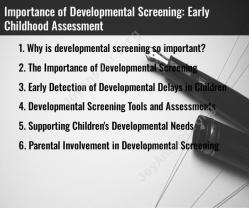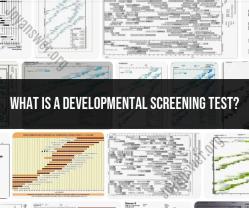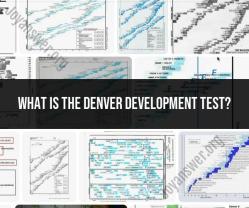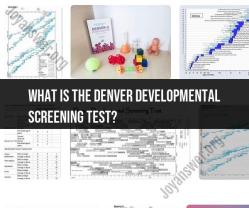What is the Denver development test?
The Denver Developmental Screening Test (DDST), often referred to as the Denver Development Test, is a widely used developmental assessment tool for young children. It is designed to help healthcare professionals and educators identify developmental delays and potential issues in children from birth to 6 years of age. The test assesses a child's skills and milestones in various areas of development, including:
Personal-Social: This category assesses a child's social and self-help skills, such as how they interact with others and their ability to dress, feed, and take care of basic personal needs.
Fine Motor-Adaptive: It evaluates fine motor skills, including a child's ability to manipulate small objects, draw, and perform tasks that require coordination and precision.
Language: This section assesses a child's speech and language development, including their ability to understand and use language, as well as their vocabulary and communication skills.
Gross Motor: It focuses on gross motor skills, such as crawling, walking, jumping, and other physical activities that involve larger muscle groups.
The Denver Developmental Screening Test is typically administered through a series of age-appropriate activities and questions that are used to gauge a child's developmental progress. Healthcare professionals or educators score the child's performance against age-specific benchmarks to determine if they are reaching typical developmental milestones for their age. If a child's performance falls significantly behind the expected milestones, it may indicate a potential developmental delay or issue that requires further assessment and intervention.
It's important to note that the Denver Developmental Screening Test is not a diagnostic tool but a screening tool to identify children who may benefit from further evaluation and support. If concerns are raised during the screening, a child may be referred for a more comprehensive developmental assessment or evaluation by a specialist.
The DDST has been widely used for many years, but there are other developmental screening tools and assessments available as well. It's essential for parents, caregivers, and professionals to work together to monitor and support a child's healthy development, and these assessments are one part of that process.
The Denver Development Test: Assessing Child Development Milestones
The Denver Development Test (DDST) is a developmental screening test used to assess the development of children from birth to age 6. It is one of the most widely used developmental screening tests in the world.
The DDST is divided into four areas of development:
- Gross motor: This includes skills such as rolling over, sitting up, crawling, walking, and running.
- Fine motor: This includes skills such as grasping objects, using utensils, and drawing.
- Language: This includes skills such as babbling, speaking words, and understanding language.
- Personal-social: This includes skills such as smiling, interacting with others, and dressing independently.
The DDST is administered by a trained healthcare professional, such as a pediatrician, nurse practitioner, or child development specialist. The test takes about 30 minutes to complete.
The History and Significance of the Denver Development Test
The DDST was developed in the 1960s by William Frankenburg and Joan Dodds. The test was originally designed to be used by pediatricians to screen for developmental delays in young children. However, the DDST is now used by a variety of healthcare professionals and in a variety of settings, including schools, early intervention programs, and childcare centers.
The DDST is significant because it is a simple, easy-to-use tool that can be used to identify children who may be at risk for developmental delays. Early identification of developmental delays is important because it allows for early intervention, which can improve a child's long-term outcomes.
What to Expect During the Denver Development Test
During the DDST, the healthcare professional will observe your child perform a variety of tasks, such as rolling over, sitting up, crawling, walking, using utensils, and drawing. The healthcare professional will also ask you questions about your child's development, such as when they first smiled, rolled over, and sat up.
Utilizing the DDST as a Tool for Early Intervention
The DDST can be used as a tool for early intervention by identifying children who may be at risk for developmental delays. If your child's results on the DDST show that they are behind in one or more areas of development, the healthcare professional may refer you to an early intervention program.
Early intervention programs provide support and services to children who are at risk for developmental delays. These programs can help children to reach their full potential by providing them with the services they need, such as speech therapy, occupational therapy, and physical therapy.
Challenges and Controversies Surrounding the Denver Development Test
One of the challenges associated with the DDST is that it can be difficult to administer accurately. The test is dependent on the skills and experience of the healthcare professional administering it.
Another challenge associated with the DDST is that it is not a diagnostic tool. If your child's results on the DDST show that they are behind in one or more areas of development, it does not necessarily mean that they have a developmental delay. More comprehensive testing may be needed to confirm a diagnosis of a developmental delay.
Despite these challenges, the DDST remains a valuable tool for assessing child development and identifying children who may be at risk for developmental delays. Early identification and intervention can make a significant difference in the long-term outcomes of children with developmental delays.







